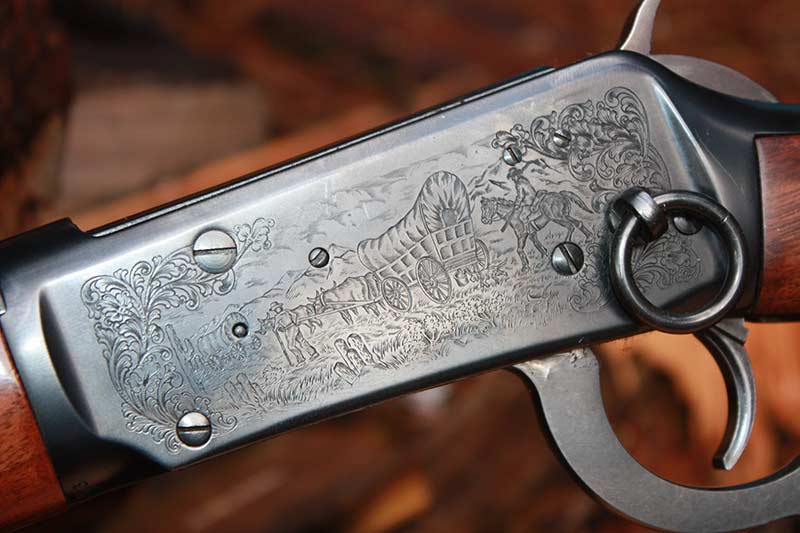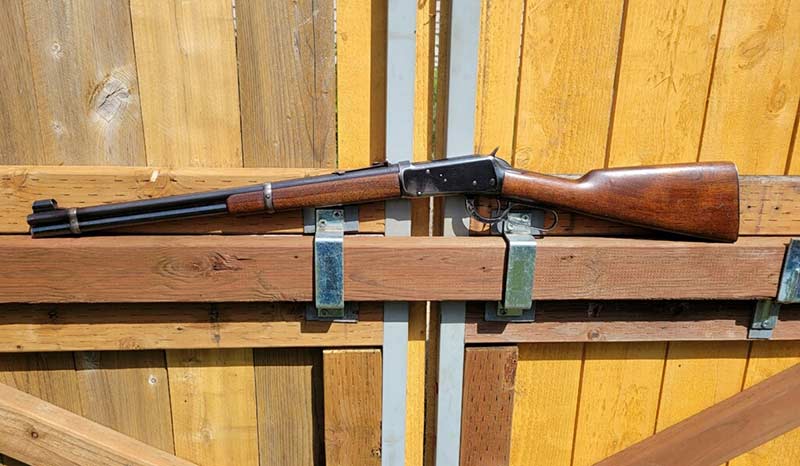But I never really gave up on the Model 94 platform, or the cartridge. Eventually, in 1992, along came a loop-lever Winchester Wrangler in .32 Special. It had standard iron sights, roll engraving on the receiver which was equipped with a saddle ring, and a 16” barrel. It held five cartridges in the tubular magazine; certainly enough to get the job done.
The short barrel length struck me as a pretty good idea for hunting my kind of brush country. At 100 yards, I could hit a deer behind the shoulders easily and visits to the range using 170-grain factory ammunition were satisfactory.
The .32 Special was originally developed with smokeless powder, but the slower rifling twist of 1:16-inch was used to allow for reloading with black powder back around the turn of the 20th Century when the cartridge was introduced. There was also the suggestion the 1:16-inch twist was the same used for the older .32-40 Winchester, so the company stuck with that rate-of-twist for the newer cartridge.
Whether either story is the precise truth never really mattered to me because I’ve seen enough venison hanging to figure out the .32 Special gets the job done.
The Special .32 Special
The .32 Winchester Special is a cartridge I’ve never really understood, but it played a rather important role in my early life.
As cartridges go, it’s pretty close ballistically to the .30-30 Winchester — which has a faster rifling twist — and they’ve both got about the same effective range. At first glance, it’s difficult to tell one cartridge from the other.
But it was my dad’s choice for a deer rifle and he was pretty good with it. When I was a youngster, he nearly always came home on the opener with a blacktail buck, taken near the top of Storm King Mountain in east Lewis County. He had a spot up there, back in the timber where deer seemed to walk into his range, and he would hang the bucks in the garage, bury the hides out in the field behind our tiny house and we would eat venison through the winter.
Dad’s rifle was rather plain, a Model 94 Winchester with a steel buttplate. While it was and remains a good rifle, it’s not the kind of gun one should learn with, the one error my dad made when he wanted to take me deer hunting. The recoil on a 12-year-old shoulder was brutal and I developed a nasty flinch. I also couldn’t hit anything because the stock was too long and I simply couldn’t get a good hold. Ultimately, the rifle scared me.
So, it was not to be that I would clobber my first buck with that Model 94. That one involved my grandfather’s .300 Savage Model 99 but I had more meat on my bones by then and the recoil didn’t have the same jolt. My brother became the owner after dad passed at the too-young age of 50 and he hunted with it until I bought him a bolt-action rifle as a gift some years later.
I also never got to hunt with my dad in his stand on top of the mountain. My first season opener was the day following the famous Columbus Day storm which hit Washington State in October 1962. The logging road leading up the slopes of Storm King had been blocked by windfalls, and the timbered top — we later learned — had been reduced to a pile of downed timber. In the process, all the deer had fled to lower elevations. My dad never hunted there again.
To load for the Wrangler, I rounded up some RCBS loading dies, a couple of boxes of Speer .321-caliber bullets and went to work. I settled with IMR 4895 as a propellant and spent some fine time at the range punching respectable groups within 2.5-3” at 100 yards and much tighter at closer ranges, which are the distances at which the bulk of blacktail deer are taken in the environment where I hunted at the time.
Because of its tubular magazine, one doesn’t load with spitzer-type bullets. A few years ago, however, Hornady introduced a 165-grain load for the .32 Special featuring the “Flex-Tip” bullet with the softer pointed tip. At the muzzle, they have an advertised velocity of 2,410 fps, but that must be from a slightly longer barrel than the 16” Wrangler tube.
Admittedly, the loop lever was an attraction. John Wayne made it famous. It seemed practical for hunting the late buck season while wearing heavy gloves. A pal of mine who was guiding at the time said it was the perfect gun for hunting deer in Western Washington. And, yes I was able to spin it rather well but didn’t make a habit of it, and never did it with live ammunition.
There is also the weight. One could easily carry that little Wrangler all day long without experiencing any fatigue. Only a few thousand were made, and today they fetch decent prices if they’re in good shape. Mine, of course, would never be for sale.
I found a good rifle scabbard from Hunter Leather and whenever my Wrangler goes along for a ride, the scabbard goes as well.
Opening day of 1984, as I recall, I was hunting some private timberland a few miles from home. I picked up a track and started following it, through a mix of hemlock and fir, back out to the gravel road and then into similar cover on the other side. And suddenly, there he was, a blacktail spike, staring intently at me, waiting for me to make the next move. He was no more than 50 yards away and the Wrangler came up fast, my sights lined up and I fired. The whole motion may have taken a couple of seconds.
The buck swung around and I fired a second time, dropping him on the move. My dad’s cartridge had done it, again.







